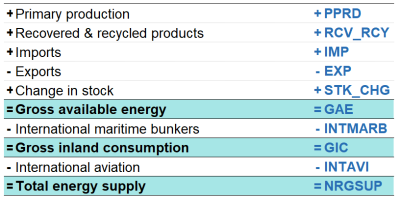Glossary:Gross inland energy consumption
Gross inland energy consumption, sometimes abbreviated as gross inland consumption, means the overall supply of energy for all activities on the territory of the country, but excluding international maritime bunkers. It includes energy needs for energy transformation (including generating electricity from combustible fuels), support operations of the energy sector itself, transmission and distribution losses, final energy consumption (industry, transport, households, services, agriculture, ...) and the use of fossil fuel products for non-energy purposes (e.g. in the chemical industry). It excludes international maritime bunkers, but it might include other fuels purchased within the country that are used elsewhere (e.g. international aviation and “fuel tourism” in the case of road transport).
This aggregate is calculated using the following formula:
Gross inland energy consumption = Primary production + Recovered & Recycled products + Imports – Export + Stock changes – International maritime bunkers
Total energy supply for the total of all products (fuels) is one of the key aggregates in energy balances. Its interpretation for individual products (fuels) is varying and needs to take into consideration other parts of energy balances. For secondary products, which are produced as transformation output in the middle block of energy balances, the Total energy supply can be negative as it reflects only on the trade and stock changes.
